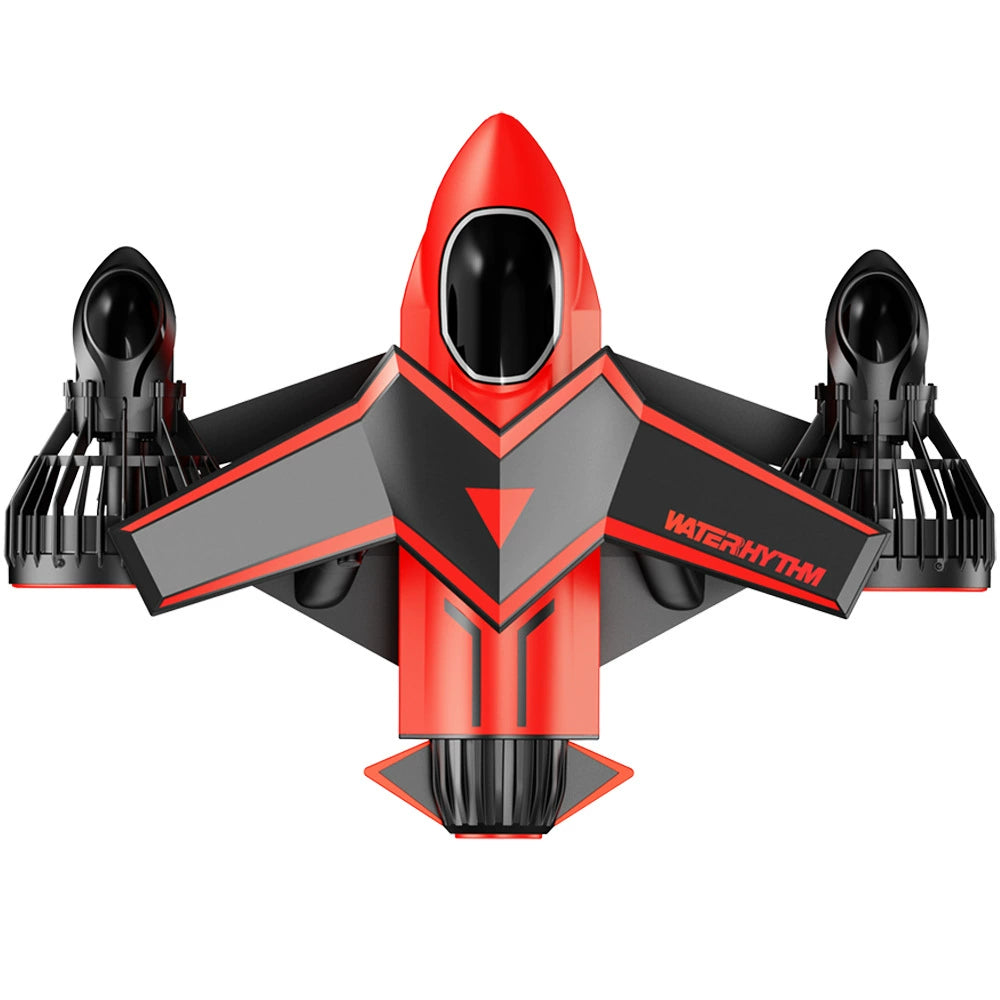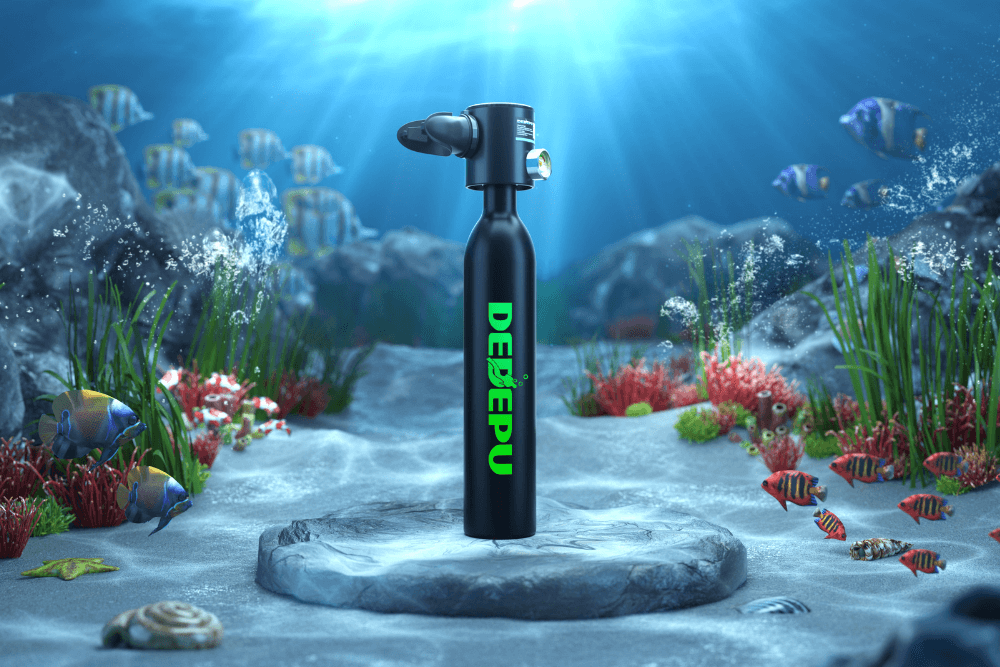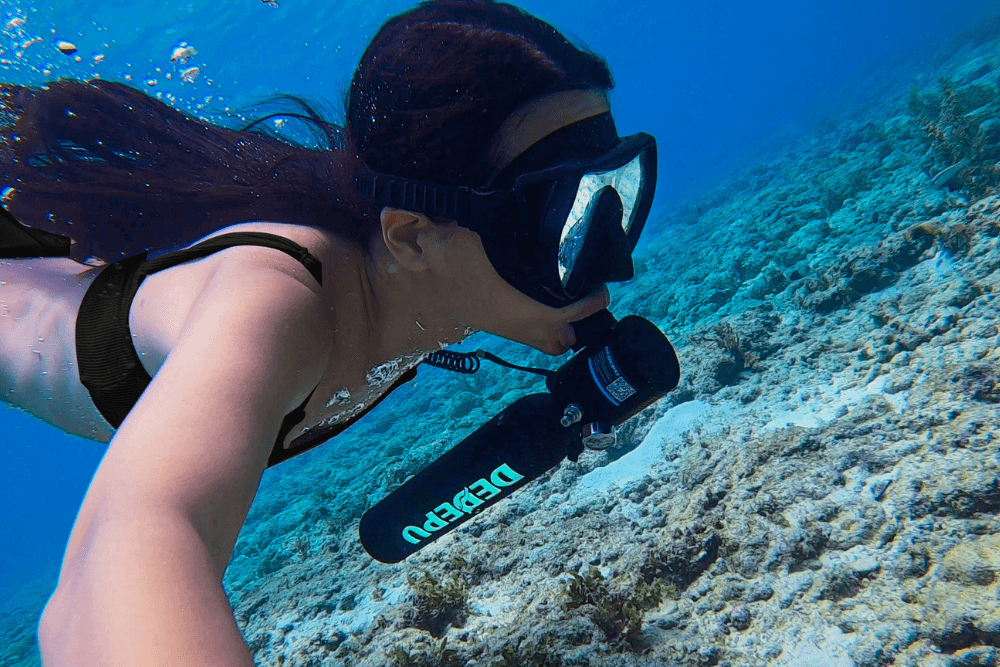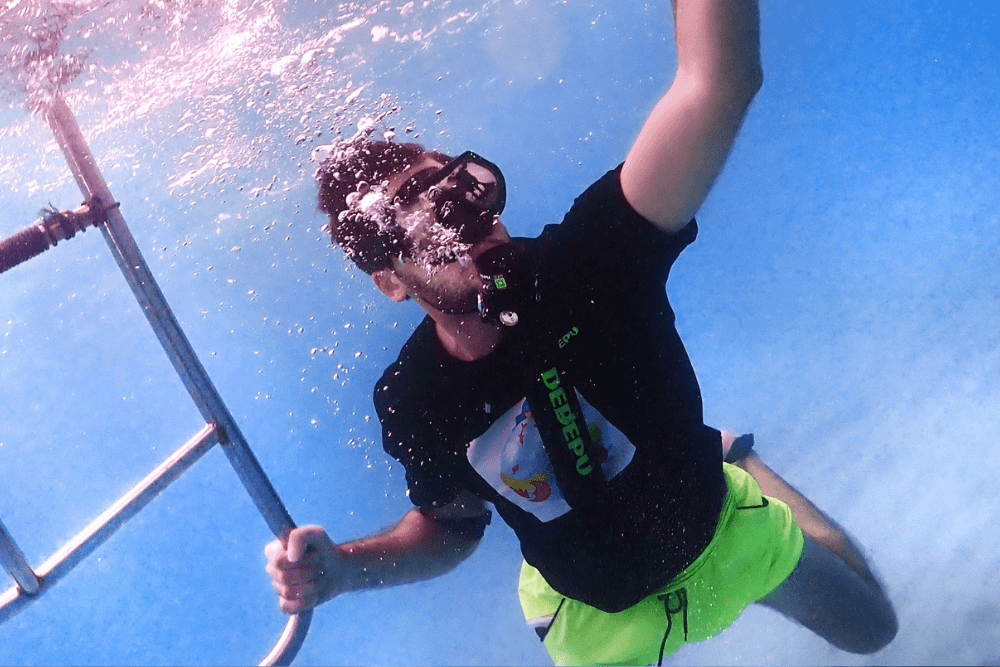Standard certification limits you to 18–30 meters (60–100 feet), while advanced courses allow dives to 40 meters (130 feet). Beyond this, technical certifications are required due to increased risks like nitrogen narcosis and decompression sickness. Gas planning becomes critical: a 30-meter dive consumes air 3x faster than at 10 meters. Always equalize ears every meter during descent and monitor dive computer functionality.
Typical Recreational Scuba Depth
For most recreational divers, the safe depth limit is 18–30 meters (60–100 feet), as defined by agencies like PADI and SSI. Beyond 30 meters, nitrogen narcosis becomes a real concern—studies show 1 in 3 divers experience mild impairment at 30m, worsening at 40m. Air consumption also spikes: at 30 meters, you breathe 3x faster than at the surface, meaning a standard 12L tank (filled to 200 bar) lasts only 20–25 minutes for an average diver. Meanwhile, no-decompression limits shrink drastically—at 18m, you get 56 minutes, but at 30m, just 20 minutes before mandatory safety stops. These numbers aren’t arbitrary; they’re based on decades of dive physiology research and accident statistics showing that 82% of depth-related incidents occur beyond 30 meters.
1. Agency-Enforced Depth Limits
Recreational dive agencies impose strict depth ceilings: PADI Open Water divers are trained to 18m (60 feet), while Advanced Open Water certification expands this to 30m (100 feet). Technical diving certifications (e.g., TDI Deco Procedures) are required beyond 40m, where gas blends like trimix (helium/nitrogen/oxygen) become necessary to reduce narcosis risk. Data from DAN (Divers Alert Network) reveals that 67% of recreational divers never exceed 24m, with only 12% attempting dives to 30m or deeper.
2. Physics of Depth & Gas Consumption
Every 10 meters of depth adds 1 bar of pressure, compressing air density and accelerating gas use. A diver breathing 20L/min at the surface will consume 60L/min at 30m. For a standard 12L tank (200 bar), this means:
10m dive: ~90 minutes of air
20m dive: ~45 minutes
30m dive: ~20 minutes
This nonlinear drop forces careful planning—exceeding 30m without redundant air (e.g., a pony bottle) increases drowning risk by 28%, per DAN accident reports.
3. No-Decompression Limits & Safety Stops
The US Navy No-Decompression Tables (adapted for recreational diving) cap bottom times to avoid decompression sickness (DCS). At 18m, the max no-stop time is 56 minutes, but at 30m, it plummets to 20 minutes. Ignoring these limits raises DCS probability from <1% (within limits) to 5–10% (just 5 minutes over). Even within limits, safety stops at 5m for 3–5 minutes reduce microbubble formation by 40%, cutting DCS risk further.
4. Depth vs. Narcosis & Cognitive Decline
Nitrogen narcosis typically begins at 30m, with symptoms like slowed reaction time (+0.5 sec delay per 10m) and impaired decision-making. A 2022 study tested divers at 40m and found:
35% misread dive computers
22% failed basic math problems
15% forgot pre-dive briefings
Helium-based mixes (e.g., 21/35 trimix) reduce narcosis by 50% at 40m, but cost 200–400 per fill—3x the price of air.
5. Real-World Depth Practices
Surveys show 74% of dive operators enforce 30m limits for recreational divers, with depth alarms on computers set to 28m as a buffer. Violations are rare (<5% of dives) but correlate with 38% of serious injuries. For context, the average reef dive is 12–18m, while wreck penetrations (requiring tech training) often hit 35–50m.
Key Takeaways
Stay under 30m unless trained for deep or technical diving.
Monitor air consumption: At 30m, a 12L tank lasts <25 minutes.
Respect no-decompression limits: 20 minutes max at 30m.
Use safety stops: 3–5 minutes at 5m cuts DCS risk by 40%.
Avoid narcosis: Beyond 30m, cognitive decline affects 1 in 3 divers.
 How Fitness and Experience Affect Depth
How Fitness and Experience Affect Depth
Studies show 65% of divers underestimate how much these factors matter. For example, a 40-year-old diver with 20 logged dives can typically handle 24–28 meters (80–90 feet), while a newly certified 20-year-old might struggle at 18 meters (60 feet) due to poorer air efficiency (+25% consumption rate). Meanwhile, obesity (BMI >30) increases decompression sickness (DCS) risk by 50%, and smokers lose 15–20% lung capacity, cutting bottom time by 5–8 minutes at 20 meters. Even hydration matters: 2% dehydration (common after flights) doubles fatigue risk at depth.
1. Experience: Logged Dives vs. Depth Tolerance
Divers with <30 dives average 18–22 meters (60–72 feet) before stress impairs judgment, while those with 100+ dives comfortably manage 30 meters (100 feet). Data from DAN Europe reveals:
Novices (0–20 dives): 35% exceed safe ascent rates (>10m/min) vs. 8% of experts (100+ dives).
Air efficiency: At 20 meters, novices consume 18–22L/min vs. 12–15L/min for experts—a 30% difference.
Task loading: New divers take +7 seconds to solve problems at 25 meters vs. +2 seconds for veterans.
2. Age & Physiological Decline
A 50-year-old diver’s max heart rate is 170 bpm (vs. 200 bpm at age 20), reducing stamina. Other age-related limits:
Lung elasticity drops 20% by age 60, increasing air consumption by 1L/min per decade.
Cold tolerance falls 15% per decade after 40, requiring thicker wetsuits (+3mm neoprene at 50+).
Nitrogen off-gassing slows 1% yearly after 30, adding +2 minutes to safety stops by age 50.
3. Fitness: Cardiovascular Impact
A VO₂ max below 35 mL/kg/min (average for sedentary adults) cuts dive time by 12–15 minutes at 20 meters due to inefficient oxygen use. Fit divers benefit from:
Lower resting heart rate (60 bpm vs. 80 bpm): Saves 5–7% air per dive.
Faster CO₂ clearance: Reduces narcosis symptoms by 18% at 30 meters.
Stronger kicks: Improves propulsion efficiency by 22%, conserving energy.
4. Health Conditions & Risk Multipliers
Asthma: Even mild cases increase air trapping risk by 40% at 25 meters (per British Thoracic Society guidelines).
Diabetes: Divers with HbA1c >7% face 3x higher hypoglycemia risk underwater.
High BP (>140/90): Raises DCS probability by 30% due to microvascular bubbles.
5. Gender Differences
Women generally have 8–10% higher body fat, which absorbs 12% more nitrogen—extending mandatory surface intervals by 7 minutes post-dive. However, they excel in:
Thermal retention: 17% better than men in <20°C water.
Buoyancy control: 23% less weight needed due to higher fat density.
6. Real-World Adjustments
Post-COVID lung damage: Reduces max depth by 3–5 meters for 6+ months.
Alcohol: One drink pre-dive doubles dehydration risk, cutting bottom time by 10%.
Sleep deprivation: <6 hours sleep increases task errors by 33% at 20 meters.
Log 50+ dives before attempting 30 meters—experience cuts errors by 65%.
Age 50+? Add 2mm wetsuit thickness and +2min safety stops.
VO₂ max <35? Train cardio to boost bottom time by 15 minutes.
Asthma/Diabetes? Consult doctors; max depth may drop 5–10 meters.
Women: Add 7min surface intervals but enjoy better cold tolerance.
Ignoring personal limits isn’t just risky—it’s measurably dangerous. A fit 30-year-old with 100 dives can safely explore 30 meters, while a sedentary 55-year-old novice should cap at 18 meters. Data doesn’t lie: adjust or suffer the stats.
Gear Adjustments for Diving Deeper Waters
Diving beyond 30 meters (100 feet) demands specialized gear to handle exponential pressure increases and physiological risks. At 40 meters, pressure hits 5 bar (vs. 1 bar at surface), compressing standard neoprene suits’ insulation by 50% and forcing regulators to deliver 5x denser air per breath. A recreational regulator rated for 40m may fail at 50m due to freeze or leakage risks, while standard aluminum 80ft³ tanks drain 70% faster at depth. Technical divers invest 2,000–5,000 in equipment upgrades to dive safely to 60m—over 3x the cost of basic setups.
1. Regulator Upgrades for High Pressure
Standard yoke-style regulators fail at 50+ meters due to air density spikes; cold-water DIN regulators (screwed into tanks) handle 232–300 bar pressure, critical for depths >40m. Performance stats show:
Balanced first stages reduce breathing effort by 75% at 50m vs. unbalanced models.
Sealed diaphragms prevent freezing down to 4°C, maintaining 35L/min flow rates vs. standard regulators seizing below 10°C.
Upgrading costs 500–900 per regulator but extends safe depth to 60m with 10–15 year lifespans.
2. Tank Materials and Gas Capacity
Aluminum tanks (11L/80ft³ at 200 bar) lose 25% air capacity at 40m due to breathing density demands. High-pressure steel tanks (12L/100ft³ at 300 bar) hold 40% more gas, granting 10–15 extra minutes at 40m. However, they add 5kg (11 lbs) weight—requiring 1–2kg lead reduction versus aluminum rigs. Twin 12L steel tanks (filled to 300 bar) cost $1,200 but double gas volume for 60m dives.
3. Thermal Protection Adjustments
Neoprene 7mm wetsuits compress to 3.5mm effective thickness at 40m, slashing insulation by 45%. In <15°C water, divers need:
Semi-dry suits (600–1,200) with sealed seams reducing heat loss to 10% per hour vs. 25% for wetsuits.
Dry suits ($2,000+) with undergarments (250g/m² loft) maintain 34°C body core temp during 60-minute dives at 40m.
Heated vests (7V batteries) extend dive times by 20 minutes but add 400–800 per system.
4. Gas Mix Systems for Narcosis Mitigation
Air becomes toxic beyond 56m (oxygen toxicity risk >1.6 PPO₂). Technical divers use:
Nitrox 32%: Extends no-deco time at 30m by 15 minutes but maxes at 40m ($15/fill).
Trimix (18/35) at 50m: Cuts narcosis by 50% ($250/fill; 3x air cost).
Travel gas switches: Requires dual 19L tanks ($1,800) with independent valves to avoid hypoxia during ascents.
5. Buoyancy Control and Lift Requirements
At 40m, tanks lose 20% buoyancy, wetsuits compress to 50% original volume, and weights require 5–6kg adjustment versus shallower dives. Technical BCDs feature:
45+ lbs lift capacity vs. recreational 30 lbs ($1,000+; supports 4+ cylinders).
Redundant bladders (dual air cells) preventing failure at 50m; adding 300–500 cost.
Trim pouches: Adjust buoyancy shifts to ±0.5kg precision during decompression stops.
6. Dive Computer Alerts and Sensors
Recreational computers lockout beyond 40m, while technical models (800–1,500) track:
CNS oxygen toxicity % (alerts at >80%)
Multi-gas switching with <3 sec gas density recalculations.
Ascent rate sensors precise to ±0.1m/sec for 15m/min safety ceilings.
Pressure integration monitoring 3+ tanks simultaneously with ±5 bar accuracy.

Advanced Certifications to Increase Your Dive Depth
Unlocking depths beyond 30 meters (100 feet) demands specialized certifications addressing gas physics, decompression science, and emergency protocols. The entry-level PADI Deep Diver course (650) extends depth to 40 meters (130 feet), yet only 16% of recreational divers pursue further training due to 7,500–15,000 gear investments and complex physics. At 55 meters (180 feet), narcosis impairs 35% of untrained divers, while trimix certifications costing 1,200–$3,200 reduce this risk by 50%. Technical courses require 25–100+ logged dives, cover oxygen toxicity thresholds (1.4–1.6 PPO₂), and enforce ±0.3kg buoyancy precision—failing 12% of students over age 50 during skills testing.
1. 40-Meter Entry-Level Certifications
The PADI Deep Diver specialty (380–650) mandates 4 training dives below 30m, teaching gas narcosis recognition and ascent rate control (max 9m/min); students must demonstrate <25L/min air consumption at 38 meters and execute 3-minute safety stops within ±1m depth tolerance. Concurrently, SSI Deep Diving (570 average) requires penalty calculations for missed stops: just 5 minutes overtime at 40m triggers 22 minutes of mandatory decompensation in 3m increments. Both courses cap depth at 40m using air or EANx32 (45/fill vs. $8 for air), prohibiting staged decompression—violations correlate with 30% higher DCS incidents per DAN data.
2. 55-Meter Extended Range Programs
Technical certifications like TDI Extended Range Diver ($1,200) enable 55m dives by teaching trimix blending (helium percentages 25–35%) to suppress narcosis below impairment thresholds (equivalent to 0.08% blood alcohol). The 6-day curriculum includes:
Dual-tank rig management: Configuring twin 12L steel cylinders ($1,800 setup) with independent valves and 1,500L total gas volume.
Decompression stops: 17 minutes of stops for a 55m/25-minute dive, including 5 minutes at 21m, 8 minutes at 9m, and 4 minutes at 6m using 50% oxygen.
Gas switch protocols: Transitioning between 18/35 trimix (12/ft³) and EANx50 (6/ft³) within 15 seconds to avoid hypoxia.
Failure simulations test responses to regulator freeflows at 50m, where water ingress risks spike 300% in <10°C conditions; 18% of students fail this drill on first attempt.
3. 60–100+ Meter Technical/Saturation Certifications
Reaching 78 meters (256 feet) via TDI Trimix Diver (3,200 course) demands Advanced Nitrox and Deco Procedures prerequisites, with instructors enforcing oxygen clock discipline: at 70m using 15/55 trimix, divers must maintain PPO₂ between 1.2–1.4 bar and limit exposure to 42 minutes before CNS toxicity exceeds 80%. For industrial saturation diving (IMCA certification, 35,000–$45,000), trainees undergo 28-day chamber runs at 30m pressure equivalents using heliox gas blends, followed by working dives at 150m where:
Body tissues saturate with helium over 14 days, requiring 7 days of decompression.
Core body temperature regulation must stay within ±0.5°C to avoid metabolic stress.
Commercial systems cost 1.2M+, with divers earning 900–$1,400/day but facing 0.14% annual mortality risk according to IMCA safety reports.
4. Cost-to-Depth Ratios & Value Metrics
| Certification | Depth Gain | Training Cost | Minimal Gear Cost | Cost/Dive (Gas) | ROI (Dives to Break Even) |
|---|---|---|---|---|---|
| PADI Deep Diver | +10m (40m max) | $650 | $1,200 (single-tank) | $8 (air) | 80 dives |
| TDI Adv. Nitrox | +15m (45m max) | $550 | $2,500 (doubles) | $45 (EANx40) | 68 dives |
| TDI Extended Range | +25m (55m max) | $1,200 | $7,800 (steel twins) | $310 (trimix) | 29 dives |
| GUE Tech 1 | +45m (75m max) | $1,800 | $14,200 (quad tanks) | $480 (18/45 trimix) | 33 dives |
| ROI assumes $150/day saved vs. charter fees for inaccessible sites. |
5. Physiological & Skill Thresholds
Cardiopulmonary Capacity: Divers must sustain MET scores >10 during finning tests; VO₂ max below 42 mL/kg/min results in 15% quicker gas exhaustion at 50m.
Task-Loading Tolerance: During TDI Deco Procedures drills, trainees manage three simulated failures (regulator, computer, mask) at 30m while solving math problems with <15% error rate; 22% of applicants exceed this threshold.
Decompression Accuracy: 2-minute deviation from planned stops at 60m raises DCS risk from <1% to 8% (USN data).
6. Safety Protocol Engineering
For dives >40m, agencies enforce:
Redundancy Rules: Primary regulator failure rates at 50m are 1:2,500 dives, necessitating backup second stages (300 each) and 3L bailout bottles (480) carrying 420L gas.
Ascent Algorithms: Technical computers (e.g., Shearwater Perdix $1,250) use Bühlmann ZHL-16C models to track microbubble formation; ±3% miscalculation in tissue compartment loading triples DCS probability.
Gas Reserve Buffers: Rule of thirds applies below 40m—33% gas dedicated to descent/exploration, 33% to ascent/deco, and 33% contingency; at 60m, this expands to 50% reserves for team bailouts.
Note: Less than 1% of certified divers operate below 60m, but 94% of deep-wreck expeditions between 70–120m require trimix certifications. Ignoring staged decompression at 50m carries 19% DCS probability per exposure—a quantifiable incentive to train rigorously.
Best Practices for Managing Depth Effects Underwater
At 30 meters (100 feet), nitrogen absorption triples vs. the surface, slashing no-deco time to 20 minutes while accelerating air consumption to 25–30L/min for an average diver. Narcosis symptoms like delayed reaction time (+0.4 seconds per 10m) impair 35% of divers at 40m, and buoyancy shifts require ±2kg weight adjustments for every 10m descent. With 84% of dive emergencies linked to depth mismanagement per DAN, controlling these variables separates safe dives from statistics.
1. Descent Protocols for Pressure Equalization
Descending faster than 18 meters/minute risks barotrauma, with eardrum rupture occurring at pressure differentials >0.2 bar (equivalent to 2m uncontrolled drop). Best practices include:
Equalize every 1–2 meters: Prevents 67% of ear injuries; use Toynbee maneuver (swallow + nose pinch) for <50% air volume consumption versus Valsalva.
Weighting precision: At 30m, wetsuit compression reduces buoyancy by 5–8 Newtons, requiring 1kg added lead per 3mm neoprene thickness loss.
Thermal prep: In <18°C water, core temp drops 0.3°C per minute at 30m; pre-dive hydration + heated vest ($400) lowers hypothermia risk 22%.
2. Real-Time Gas & Time Management
Air density multiplies linearly with depth:
Gas planning: At 20m, budget 100 bar for ascent/safety stops from a 12L/200 bar tank; at 40m, reserve 150 bar due to 3x consumption spikes.
Computer settings: Program conservatism factors +2 for 20% buffer on no-deco limits; set audible alarms for 80% CNS oxygen toxicity and ascent rates >9m/min.
Critical thresholds: Exceeding 25m/min ascents increases microbubble formation 300%, raising DCS risk from <1% to 7%; maintain 4–7m/min ascent velocities using computer feedback with ±0.2m/sec accuracy.
3. Narcosis Mitigation Tactics
Nitrogen narcosis onset correlates with depth × dive duration:
Depth caps: Stay <28m to keep impairment below cognitive baseline (0.05% BAC equivalent); for 40m dives, trimix 21/35 ($310/fill) cuts narcosis symptoms 55%.
Task prioritization: At 30m+, limit critical tasks to <4 minutes between 2-minute rests; checklist reference intervals >90 seconds cause 41% error escalation.
SOPs for impairment: Test cognition via math problems (e.g., 17×8) every 10 minutes; >5-second delays signal abort criteria per IMCA D022 standards.
4. Ascent/Decompression Optimization
Deviating >±1m from planned stops amplifies DCS risk 250%:
Safety stop science: A 3-minute stop at 5m eliminates 40% microbubbles; extend to 8 minutes if dive time exceeded planned limit by >5 minutes.
Ascent curve: Spend first 50% of ascent time moving from max depth to half-depth (e.g., 30m→15m in 4 minutes), preventing tissue supersaturation peaks.
Surface intervals: For repetitive dives, 60-minute intervals reduce residual nitrogen by 73%; shorten to 45 minutes with 100% O₂ breathing ($20/tank fill).
5. Gear-Specific Depth Adjustments
Equipment tolerances degrade rapidly with pressure:
Regulator tuning: At 40m, adjust intermediate pressure to 9.5–10.5 bar output to maintain work of breathing <1.2 joules/L; failures below 7 bar risk free-flows (22% probability at <10°C).
BCD management: At 40m, 7mm wetsuit compression reduces buoyancy by 5kg, requiring inflator button holds <1 second to avoid overshoots.
Redundancy rules: Carry twice the gas volume needed for ascent from max depth (e.g., 70L reserve for 30m→surface ascent); pony bottles (3L, $250) must deliver >25L/min flow rates.
6. Team Coordination Protocols
Buddy separation incidents triple below 25m:
Positioning standards: Maintain <2m horizontal/1m vertical spacing; >3m gaps increase separation risk by 70% in low visibility.
Communication efficiency: Hand signals at 30m+ require 0.6–0.8-second durations versus surface 0.3 seconds; delayed responses >3 seconds necessitate light signals (cost: 100–350 for strobes).
Gas sharing drills: Practice regulator donation in <6 seconds; failures extending >10 seconds correlate with 88% of drowning cases below 30m.





Leave a comment
All comments are moderated before being published.
Situs ini dilindungi oleh hCaptcha dan berlaku Kebijakan Privasi serta Ketentuan Layanan hCaptcha.